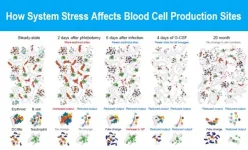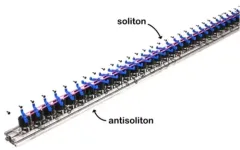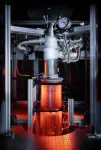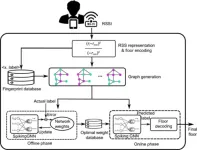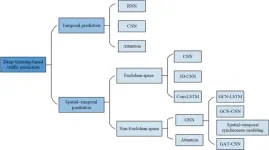(Press-News.org) Some anti-cancer treatments not only target tumour cells but also healthy cells. If their effects on the latter are too strong, their use can become limiting. A team from the University of Geneva (UNIGE), in collaboration with Basel-based FoRx Therapeutics, has identified the mechanism of action of PARP inhibitors, used in particular for breast and ovarian cancer in patients carrying the BRCA gene mutation. These inhibitors block two specific activities of the PARP proteins. By blocking one of them, the toxic effect on cancer cells is maintained, while healthy cells are preserved. This work, published in the journal Nature, will help improve the efficacy of these treatments.
Despite the thousands of lesions that damage our DNA every day, the genome of our cells is particularly stable thanks to a highly efficient repair system. Among the genes coding for repair proteins are BRCA1 and BRCA2 (for BReast CAncer 1 and 2), which are particularly involved in DNA double helix breaks. The presence of mutations in these genes (in around 2 out of every 1,000 women) can result in non-repair of damaged DNA, and greatly increase the risk of developing breast or ovarian cancer (or prostate cancer in men).
Non-cancerous cells killed by treatments
PARP inhibitors have been used to treat this type of cancer for around 15 years. PARP proteins can detect breaks or abnormal structures in the DNA double helix. PARPs then temporarily stick to the DNA, synthesizing a chain of sugars which acts as an alarm signal to recruit the proteins involved in DNA repair. Treatments based on PARP inhibitors block these activities and trap the PARP protein on the DNA. There is then no alarm signal to trigger DNA repair.
This treatment proves toxic for fast-growing cells such as cancer cells, which generate too many mutations without having time to repair them and are thus doomed to die. But our bodies are also home to fast-growing healthy cells. This is the case, for example, of hematopoietic cells - the source of red and white blood cells - which, as collateral victims, are also massively destroyed by anti-PARP treatments.
The mechanisms by which anti-PARP drugs kill cells (cancerous or not) are still poorly understood. Professor Thanos Halazonetis’ laboratory in the Department of Molecular and Cellular Biology at the UNIGE Faculty of Science, in collaboration with FoRx Therapeutics, has dissected the mechanisms of action of PARP inhibitors. The scientists used two classes of PARP inhibitors that identically block PARP’s enzymatic activity – that is, the synthesis of the sugar chain that serves as an alarm signal - but do not trap PARP on DNA with the same strength. The team observed that both inhibitors kill cancer cells with the same efficiency, but that the inhibitor that weakly binds PARP to DNA is much less toxic to healthy cells.
A warning signal to prevent DNA strand collisions
‘‘We discovered that PARP not only acts as an alarm signal to recruit DNA repair proteins, it also intervenes when abnormal DNA structures are formed as a result of collisions between different machineries that read or copy the same portion of DNA,’’ explains Michalis Petropoulos, post-doctoral fellow in the Department of Molecular and Cellular Biology at the UNIGE Faculty of Science and first author of the study.
When using anti-PARP treatment, this warning signal to prevent collisions is not triggered. These collisions between the machinery will lead to an increase in DNA lesions, which cannot be repaired in cancer cells, because they lack the BRCA repair proteins. The second activity of PARP treatments, resulting in tight binding, aka trapping, of PARPs on DNA also leads to DNA damage that needs to be repaired by cells. But this repair is not mediated by the BRCA repair proteins and, as a result, both normal and cancer cells are killed.
‘‘We therefore discovered that inhibition of the enzyme activity is sufficient to kill cancer cells, whereas trapping - when PARP is strongly bound to DNA - kills the normal cells as well, and therefore is responsible for the toxicity of these drugs,’’ summarizes Thanos Halazonetis, head of the study. ‘‘This knowledge will make it possible to develop safer PARP inhibitors that inhibit PARP’s enzymatic activity without trapping it on DNA’’.
END
Reducing the side effects of breast and ovarian cancer treatment
By showing how a type of anticancer drug kills cancer cells and damages healthy cells, a UNIGE team is paving the way for improved treatments.
2024-03-20
ELSE PRESS RELEASES FROM THIS DATE:
Skeleton-wide study of blood cell formation yields surprising findings
2024-03-20
Imagine being able to count the different types of blood cells being formed inside the tiny bones of a mouse and pinpointing the strings and clusters of cells within the bone marrow that are responsible for producing specific types of blood cells.
That’s exactly what a team of scientists led by experts at Cincinnati Children’s achieved in a far-reaching study published March 20, 2024, in the prestigious journal Nature. Their work adds unprecedented new understanding of the “elegant” and “resilient” anatomy of bone marrow while also generating evidence of unexpected variations in how the skeleton ...
MD Anderson Research Highlights for March 20, 2024
2024-03-20
HOUSTON ― The University of Texas MD Anderson Cancer Center’s Research Highlights showcases the latest breakthroughs in cancer care, research and prevention. These advances are made possible through seamless collaboration between MD Anderson’s world-leading clinicians and scientists, bringing discoveries from the lab to the clinic and back.
Recent developments at MD Anderson offer insights into a combination therapy that slows pancreatic cancer progression, an all-oral treatment for older patients with acute myeloid leukemia (AML) unable to receive intensive chemotherapy, novel targets to protect against osteoporosis and bone metastasis, the generation ...
An endless domino effect
2024-03-20
If it walks like a particle, and talks like a particle… it may still not be a particle. A topological soliton is a special type of wave or dislocation which behaves like a particle: it can move around but cannot spread out and disappear like you would expect from, say, a ripple on the surface of a pond. In a new study published in Nature, researchers from the University of Amsterdam demonstrate the atypical behaviour of topological solitons in a robotic metamaterial, something which in the future may be used to control how robots move, sense their surroundings and communicate.
Topological solitons can be found in many ...
ARPA-H appoints Etta Pisano to lead its Advancing Clinical Trials Readiness Initiative
2024-03-20
The Advanced Research Projects Agency for Health (ARPA-H) has appointed Etta D. Pisano, MD, FACR, senior portfolio lead, to build the agency's clinical trial portfolio and lead the ARPA-H Advancing Clinical Trials Readiness Initiative under ARPA-H Resilient Systems Mission Office Director Jennifer Roberts.
The first radiologist to be appointed to such a role, Dr. Pisano is an internationally recognized expert in women's health, breast cancer research, and the use of artificial intelligence in ...
Quantum tornado provides gateway to understanding black holes
2024-03-20
Scientists have for the first time created a giant quantum vortex to mimic a black hole in superfluid helium that has allowed them to see in greater detail how analogue black holes behave and interact with their surroundings.
Research led by the University of Nottingham, in collaboration with King’s College London and Newcastle University, have created a novel experimental platform: a quantum tornado. They have created a giant swirling vortex within superfluid helium that is chilled to the lowest possible temperatures. Through the observation of minute wave dynamics on the superfluid’s surface, the research team has shown that these quantum ...
Introducing Floorlocator: a game-changer in indoor navigation technology
2024-03-20
Researchers have developed FloorLocator, a breakthrough in indoor navigation technology, which combines the high efficiency of Spiking Neural Networks (SNNs) with the advanced learning capabilities of Graph Neural Networks (GNNs). This innovative approach ensures remarkable accuracy and scalability for floor localization, crucial for enhancing emergency responses, indoor positioning, and personalized recommendation systems.
Indoor positioning is transforming with applications demanding precise location tracking. Traditional methods, including fingerprinting and sensor-based techniques, though widely used, face significant drawbacks such as the ...
New survey on deep learning solutions for cellular traffic prediction
2024-03-20
The bustling streets of a modern city are filled with countless individuals using their smartphones for streaming videos, sending messages and browsing the web. In the era of rapidly expanding 5G networks and the omnipresence of mobile devices, the management of cellular traffic has become increasingly complex. To address this challenge, mobile network operators need methods for the accurate prediction of cellular traffic. A comprehensive survey published 5 Jan. in Intelligent Computing explores deep learning techniques for cellular traffic prediction.
Better cellular traffic prediction would enhance intelligent 5G network construction and resource management, thereby ...
Cellular architecture of lesions in MS now mapped out
2024-03-20
Using advanced methodology, scientists in Sweden were able to reveal at the cellular level how lesions in multiple sclerosis develop. The new results are presented in the journal Cell by researchers from Karolinska Institutet and Stockholm University.
Over 1,8 million people worldwide are diagnosed with multiple sclerosis, MS. In this disease, the body's immune cells attack the cells that form myelin, the so-called oligodendrocytes, which belong to the group of glial cells. Without myelin, signals between nerve cells cannot travel as fast as ...
ADHD medications and work disability and mental health outcomes
2024-03-20
About The Study: In this Swedish nationwide cohort study of 221,000 individuals with attention-deficit/hyperactivity disorder (ADHD), the use of ADHD medication was associated with fewer hospitalizations for both psychiatric and non-psychiatric morbidity and lower suicidal behavior.
Authors: Heidi Taipale, Ph.D., of the Karolinska Institutet in Stockholm, is the corresponding author.
To access the embargoed study: Visit our For The Media website at this link https://media.jamanetwork.com/
(doi:10.1001/jamanetworkopen.2024.2859)
Editor’s Note: Please see the article for additional information, including ...
Electrocardiographic findings in female professional basketball athletes
2024-03-20
About The Study: This study that included 173 Women’s National Basketball Association athletes provides reference electrocardiographic (ECG) data for elite female basketball athletes. International criteria–defined training-related findings were common, whereas abnormal ECG findings were rare in this athlete group. These reference data may assist basketball programs and health care professionals using ECGs in screening for female athletes and may be used as a stimulus for future female-specific ECG ...
LAST 30 PRESS RELEASES:
Tracing the quick synthesis of an industrially important catalyst
New software sheds light on cancer’s hidden genetic networks
UT Health San Antonio awarded $3 million in CPRIT grants to bolster cancer research and prevention efforts in South Texas
Third symposium spotlights global challenge of new contaminants in China’s fight against pollution
From straw to soil harmony: International team reveals how biochar supercharges carbon-smart farming
Myeloma: How AI is redrawing the map of cancer care
Manhattan E. Charurat, Ph.D., MHS invested as the Homer and Martha Gudelsky Distinguished Professor in Medicine at the University of Maryland School of Medicine
Insilico Medicine’s Pharma.AI Q4 Winter Launch Recap: Revolutionizing drug discovery with cutting-edge AI innovations, accelerating the path to pharmaceutical superintelligence
Nanoplastics have diet-dependent impacts on digestive system health
Brain neuron death occurs throughout life and increases with age, a natural human protein drug may halt neuron death in Alzheimer’s disease
SPIE and CLP announce the recipients of the 2025 Advanced Photonics Young Innovator Award
Lessons from the Caldor Fire’s Christmas Valley ‘Miracle’
Ant societies rose by trading individual protection for collective power
Research reveals how ancient viral DNA shapes early embryonic development
A molecular gatekeeper that controls protein synthesis
New ‘cloaking device’ concept to shield sensitive tech from magnetic fields
Researchers show impact of mountain building and climate change on alpine biodiversity
Study models the transition from Neanderthals to modern humans in Europe
University of Phoenix College of Doctoral Studies releases white paper on AI-driven skilling to reduce burnout and restore worker autonomy
AIs fail at the game of visual “telephone”
The levers for a sustainable food system
Potential changes in US homelessness by ending federal support for housing first programs
Vulnerability of large language models to prompt injection when providing medical advice
Researchers develop new system for high-energy-density, long-life, multi-electron transfer bromine-based flow batteries
Ending federal support for housing first programs could increase U.S. homelessness by 5% in one year, new JAMA study finds
New research uncovers molecular ‘safety switch’ shielding cancers from immune attack
Bacteria resisting viral infection can still sink carbon to ocean floor
Younger biological age may increase depression risk in older women during COVID-19
Bharat Innovates 2026 National Basecamp Showcases India’s Most Promising Deep-Tech Ventures
Here’s what determines whether your income level rises or falls
[Press-News.org] Reducing the side effects of breast and ovarian cancer treatmentBy showing how a type of anticancer drug kills cancer cells and damages healthy cells, a UNIGE team is paving the way for improved treatments.
